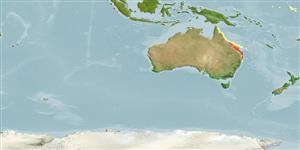Teleostei (teleosts) >
Perciformes/Scorpaenoidei (Scorpionfishes) >
Aploactinidae (Velvetfishes)
Etymology: Matsubarichthys: Because of Matsubara, icthyologist in scorpenoid fishes. He was cited by Hilgendorf, 1880, and named after Shinnosuke Matsubara, director of Imperial Fisheries in Tokyo; inusitatus: Name means unusual or rare.
Eponymy: Dr Kiyomatsu Matsubara (1907–1968) was originally called Kiyomatsu Sakamoto but on marrying he took his wife’s name as the family surname. [...] (Ref. 128868), visit book page.
Environment: milieu / climate zone / depth range / distribution range
Ecology
Marine; demersal. Tropical
Western Pacific: known only from the holotype taken in Queensland, Australia.
Size / Weight / Age
Maturity: Lm ? range ? - ? cm
Max length : 1.7 cm SL male/unsexed; (Ref. )
Dorsal spines (total): 6; Dorsal soft rays (total): 6; Anal spines: 2; Anal soft rays: 4; Vertebrae: 21. Head extremely large, depressed. Body elongate, not compressed. Caudal fin damaged (rounded, without branched rays, 10 segmented rays and 4 unsegmented). Body scales absent, except for lateral line which are extremely long and tubular; first 3 touching each other. Its distinct, densely melanic spots on the head may be a transitory larval or juvenile character but cannot be verified until larger specimens are caught (Ref. 35981).
Known only from the holotype which may be at a transitory larvae and juvenile stage with a length of 0.85 cm SL (Ref. 35981). Maximum length value is preliminary and is assumed to be twice the length of the only juvenile specimen reported.
Life cycle and mating behavior
Maturity | Reproduction | Spawning | Eggs | Fecundity | Larvae
Poss, S.G. and G.D. Johnson, 1991. Matsubarichthys inusitatus, a new genus and species of velvetfish (Scorpaeniformes: Aploactinidae) from the Great Barrier Reef. Proc. Biol. Soc. Wash. 104(3):468-473. (Ref. 35981)
IUCN Red List Status (Ref. 130435: Version 2025-1)
Threat to humans
Harmless
Human uses
Tools
Special reports
Download XML
Internet sources
Estimates based on models
Preferred temperature (Ref.
123201): 24.3 - 26.7, mean 25.6 °C (based on 64 cells).
Phylogenetic diversity index (Ref.
82804): PD
50 = 1.0000 [Uniqueness, from 0.5 = low to 2.0 = high].
Bayesian length-weight: a=0.01288 (0.00419 - 0.03963), b=3.03 (2.77 - 3.29), in cm total length, based on LWR estimates for this (Sub)family-body shape (Ref.
93245).
Trophic level (Ref.
69278): 3.0 ±0.3 se; based on size and trophs of closest relatives
Fishing Vulnerability (Ref.
59153): Low vulnerability (10 of 100).
🛈
